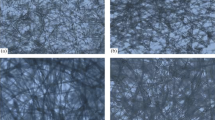Summary
In order to investigate the effects of particular arrangements of macromolecules during cross-linking on the elastic properties of the network, highly oriented fibrous natural rubber samples were cross-linked with high energy radiation and shrunk in boiling water. Stress-strain-temperature measurements were performed on the shrunken networks, the deformation being an unidirectional extension in the direction of orientation. Additional measurements of equilibrium swelling in n-decane, of birefringence and wide angle X-ray diffraction patterns for unstretched and for stretched samples were obtained.
The main results can be summarized as follows: the amount of solvent absorbed at equilibrium swelling, the ease of deformation in the direction of orientation and the range of elongation in which essentially entropy effects determine the elastic properties of the networks, are considerably smaller than for networks cross-linked in the isotropic state at the same dose. In this range of elongation, a small positive component of the intramolecular energy, similar to that observed for normal networks, is observed. At moderate elongation an upturn of the stress-strain isotherm is observed which roughly corresponds to a downturn of the energy component (δH/δL)p,T. Both the upturn and the downturn are shifted to lower elongations when a given sample is swollen with n-hexadecane.
Even in the elongation region preceding the upturn, deviations from the behavior of networks cross-linked in the isotropic state and from the rubber elasticity theory are observed. Most noticeable differences are the facts that the oriented networks are anisotropic (as evidenced by birefringence and equilibrium swelling measurements) and that the shape of the stress-strain isotherm is adequately represented by the strain functionα−1/α 2 of the rubber elasticity theory. While the role of inhomogeneity regions where chain molecules have greater tendency to crystallize than in the matrix has been emphasized, a detailed description of the structural factors responsible for these phenomena and the validity of these results for other networks formed in the oriented state, await further investigation.
Zusammenfassung
Um Effekte der besonderen Anordnung der Makromoleküle während der Vernetzung auf die elastischen Eigenschaften des Netzwerkes zu untersuchen, wurden hochorientierte Naturkautschukproben mit Strahlung hoher Energie vernetzt und in kochendem Wasser geschrumpft. Zug-Dehnungs-Verhalten in Abhängigkeit von der Temperatur wurden an diesen geschrumpften Netzwerken durchgeführt, wobei die Deformation eine einachsige Dehnung in Richtung der Orientierung war. Zusätzlich erfolgte die Untersuchung der Gleichgewichtsquellung in n-Dekan, der Doppelbrechung und der Weitwinkelstreuung für ungestreckte und gestreckte Proben.
Die wesentlichen Resultate lassen sich wie folgt zusammenfassen: Der absolute Betrag an adsorbiertem Lösungsmittel im Gleichgewicht bei der Quellung, die Leichtigkeit der Deformation in Orientierungsrichtung und der Bereich der Verlängerung, in dem im wesentlichen die Entropieeffekte die elastischen Eigenschaften des Netzwerks bestimmen, sind beträchtlich kleiner als bei Netzwerken, die mit gleicher Strahlungsdosis im isotropen Zustand vernetzt wurden. Innerhalb dieses Bereichs der Verlängerung wird ein kleiner positiver Anteil an zwischenmolekularer Energie beobachtet ähnlich dem bei normalen Netzwerken. Bei mittlerer Verlängerung ist ein Anstieg der Zug-Dehnungsisotherme zu bemerken, welche grob dem Abfall der Energiekomponente (δH/δL)p,T entspricht. Beides, Anstieg und Abfall, verlagern sich zu geringeren Verlängerungen, wenn die entsprechende Probe mit n-Hexadekan gequollen wird. Gerade in dem Verlängerungsbereich, der dem Anstieg vorangeht, sind die Abweichungen vom isotrop vernetzten Netzwerk und von der Theorie der Gummielastizität zu beobachten. Die bemerkenswertesten Unterschiede beruhen darauf, daß die orientierten Netzwerke anisotrop sind (wie auch Doppelbrechung und Gleichgewichtsquellung andeuten) und daß die Gestalt der Zug-Dehnungsisotherme durch die Dehnungsfunktion α−1/α2 der Gummitheorie gegeben wird. Während die Rolle der inhomogenen Bereiche, in denen die Kettenmoleküle größere Tendenz zur Kristallisation besitzen als in den übrigen, herausgestellt ist, erfordert eine eingehende Beschreibung der strukturellen Faktoren, die für diese Phänomene und die Gültigkeit dieser Resultate für andere Netzwerke, die im orientierten Zustand gebildet wurden, verantwortlich sind, weitere Untersuchungen.
Similar content being viewed by others
References
Treloar, L. R. G., The Physics of Rubber Elasticity, 2nd ed. (Oxford, 1958).
Ciferri, A., J. Polymer Sci.54, 149 (1961).
Flory, P. J., J. Amer. Chem. Soc.78, 5222 (1956).
Mason, P., J. Chem. Physics35, 1523 (1961).
Lodge, A. S., Kolloid-Z.171, 46 (1960).
Andrews, R. D., A. V. Tobolsky, andE. E. Hanson, J. Appl. Physics17, 352 (1946).
Berry, J. P., J. Scanlan, andW. F. Watson, Trans. Faraday Soc.52, 1137 (1956).
Flory, P. J., Trans. Faraday Soc.56, 722 (1960).
Scott, K. W. andR. S. Stein, J. Chem. Physics21, 1281 (1956).
Scanlan, J. andW. F. Watson, Trans. Faraday Soc.54, 740 (1958).
Scanlan, J., Trans. Faraday Soc.57, 839 (1961).
Charlesby, A. andE. von Arnim, J. Polymer Sci.25, 151 (1957).
Oth, J. F. M. andP. J. Flory, J. Amer. Chem. Soc.80, 1295 (1958).
Ciferri, A. andP. J. Flory, J. Appl. Physics30, 1498 (1959).
Roberts, D. E. andL. Mandelkern, J. Amer. Chem. Soc.80, 1289 (1958).
Mandelkern, L., D. E. Roberts, A. F. Diorio, andA. S. Posner, J. Amer. Chem. Soc.81, 4148 (1959).
Oth, J. F. M., Kolloid-Z.171, 1 (1960).
Speakman, P. T., Trans. Faraday Soc.57, 518 (1961).
Ciferri, A., C. A. J. Hoeve, andP. J. Flory, J. Amer. Chem. Soc.83, 1015 (1961).
Mullins, L., J. Appl. Polymer Sci.2, 257 (1959).
Bekkedahl, N. andL. A. Wood, Rubber Chem. Tech.14, 347 (1941).
Egloff, G., Physical Constants of Hydrocarbons, Vol. 5, (New York, 1953).
Voorn, M. L. andJ. J. Hermans, J. Polymer Sci.35, 113 (1959).
Ciferri, A., Makromol. Chem.43, 152 (1961).
Roe, R.-J. andW. R. Krigbaum, J. Polymer Sci.61, 167 (1962).
McCullough, R. L. andR. Hosemann, (to be published).
Hammer, C. F., W. W. Brandt, andW. L. Peticolas, J. Polymer Sci.24, 291 (1957).
Mullins, L. andN. R. Tobin, Proc. 3rd Rubber Technology Conf. 397 (1954).
Author information
Authors and Affiliations
Rights and permissions
About this article
Cite this article
Greene, A., Ciferri, A. Elastic properties of networks formed from oriented chain molecules. Kolloid-Z.u.Z.Polymere 186, 1–15 (1962). https://doi.org/10.1007/BF01797948
Received:
Issue Date:
DOI: https://doi.org/10.1007/BF01797948




